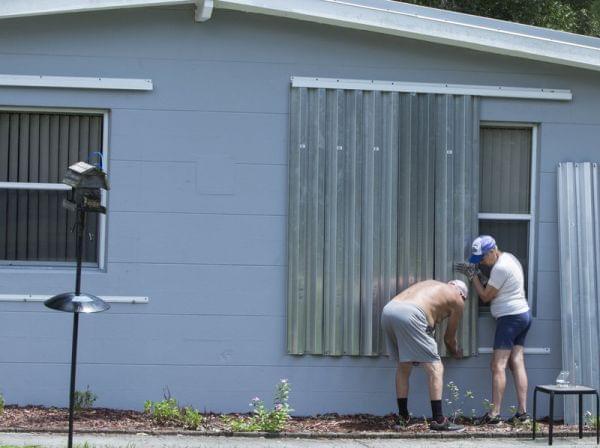U.S. Mainland Braces As Hurricane Dorian Intensifies Over The Atlantic

People in Vero Beach, Fla., install shutters on their home on Thursday in preparation for Hurricane Dorian, now expected to be a Category 4 storm when it hits the U.S. coastline. Ellis Rua/AP
The southern United States and the Bahamas are bracing for Hurricane Dorian as it slowly churns across the Atlantic and is expected to become a dangerous, Category 4 storm as it makes landfall in the days ahead.
One NOAA hurricane model showed Dorian bringing between 1 and 2 feet of rain "for basically every coastal county from Miami to North Carolina," said meteorologist Eric Holthaus. "Combined with storm surge and exceptionally high new moon tides, this would be a coastal flooding catastrophe."
Florida Gov. Ron DeSantis expanded a state of emergency to include all of the state's 67 counties, citing the storm's "uncertain path." Late Thursday, he said he sent a letter requesting that President Trump declare a pre-landfall disaster for all counties. Hours earlier, Georgia Gov. Brian Kemp declared a state of emergency in 12 counties.
On Friday morning, the Bahamas Meteorology Department issued its 12th alert on Dorian, warning of 6 to 12 inches of rainfall over the northwest Bahamas as the storm approaches on Saturday.
Latest (00Z) GFS shows Hurricane #Dorian bringing 1-2 *feet* of rainfall for basically every coastal county from Miami to North Carolina. Combined with storm surge and exceptionally high new moon tides, this would be a coastal flooding catastrophe. pic.twitter.com/vs5b8lhCk2
— Eric Holthaus (@EricHolthaus) August 30, 2019
Dorian is expected to be one of the strongest hurricanes to strike Florida's east coast in decades. The National Hurricane Center warned of an increasing likelihood of a life-threatening storm surge along parts Florida's east coast.
As of Friday morning, the hurricane was traveling at 12 mph, with maximum sustained winds of 105 mph, making it a Category 2 storm, according to the National Weather Service.
Dorian is expected to move inland, where its slow pace could mean extended misery for communities facing high winds and rainfall. The hurricane-force winds could cause long-term power outages, with areas uninhabitable for weeks or months, according to the NHC wind scale guide.
"We're fully mobilized," Greg Oravec, the mayor of Port St. Lucie, Fla., told NPR. "At this point, everyone should be taking Friday and Saturday and putting up their shutters." He emphasized that residents should protect their structures from gusty winds and have seven days' worth of food, water and medicine stored.
Although the storm's track is still uncertain on the Florida peninsula, President Trump's Mar-a-Lago resort in Palm Beach and the Trump Doral resort near Miami are in the vicinity of Dorian's projected path. The Miami Herald reported that all employees of Mar-a-Lago except for security personnel were sent home for the duration of the storm. Doral's pool and other amenities were reportedly closed with generators ready to supply back-up power if necessary.
Trump canceled his plans to travel to Poland this weekend as the hurricane neared.
Dorian's approach comes days after the Trump administration announced that it would divert $271 million in funds from the Federal Emergency Management Agency — including $155 million from FEMA's disaster relief fund — to other units in the Department of Homeland Security in an effort to support the president's border enforcement priorities.
Photographs showed stores with cleared out shelves as people got ready for the storm's arrival. Home Depot announced Thursday that it had sent more than 160 truckloads of supplies to stores to help people prepare.
Dorian passed over parts of Puerto Rico, St. Thomas and other islands in the Caribbean on Wednesday, causing power outages and flooding as it gained strength.

